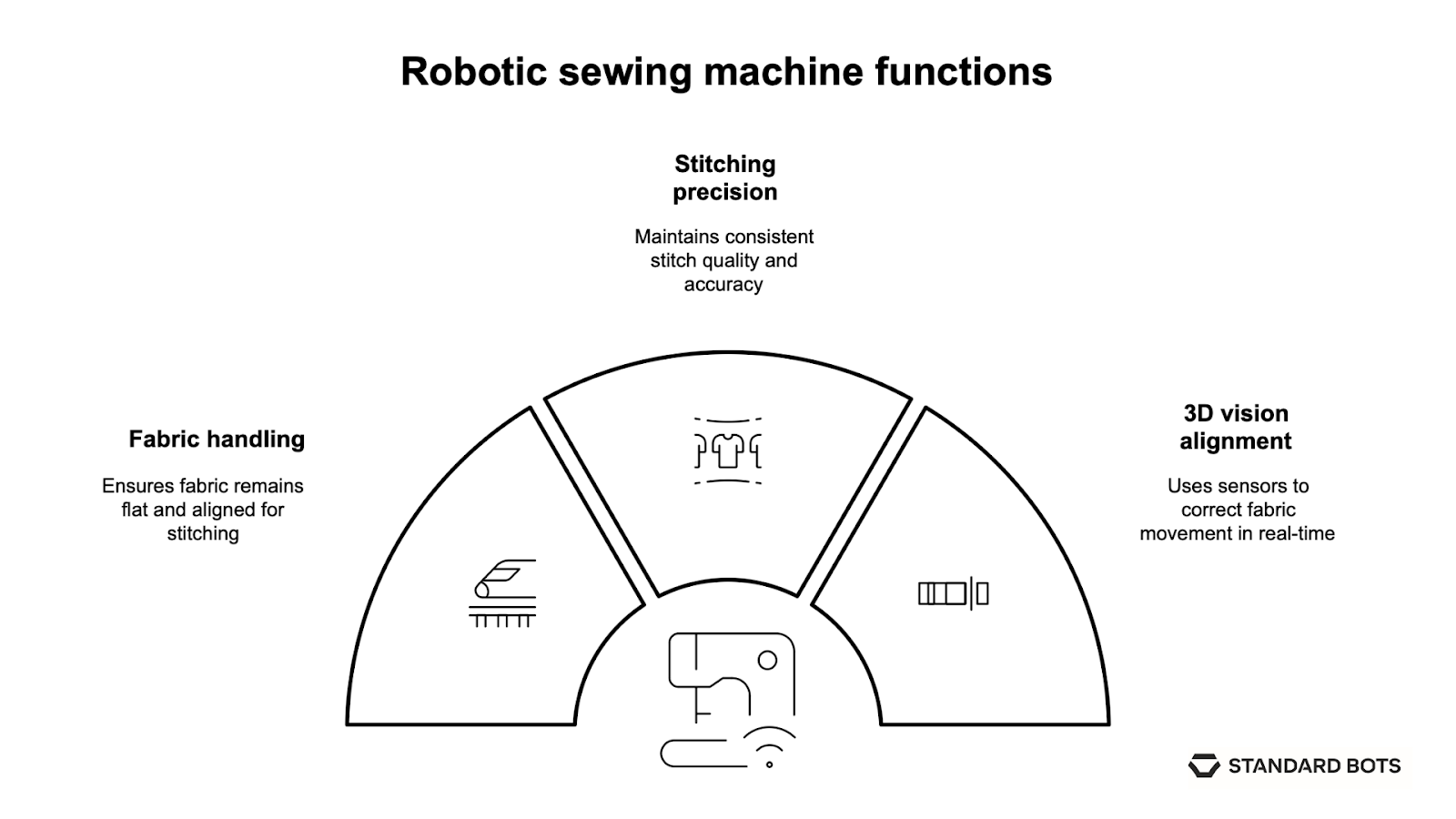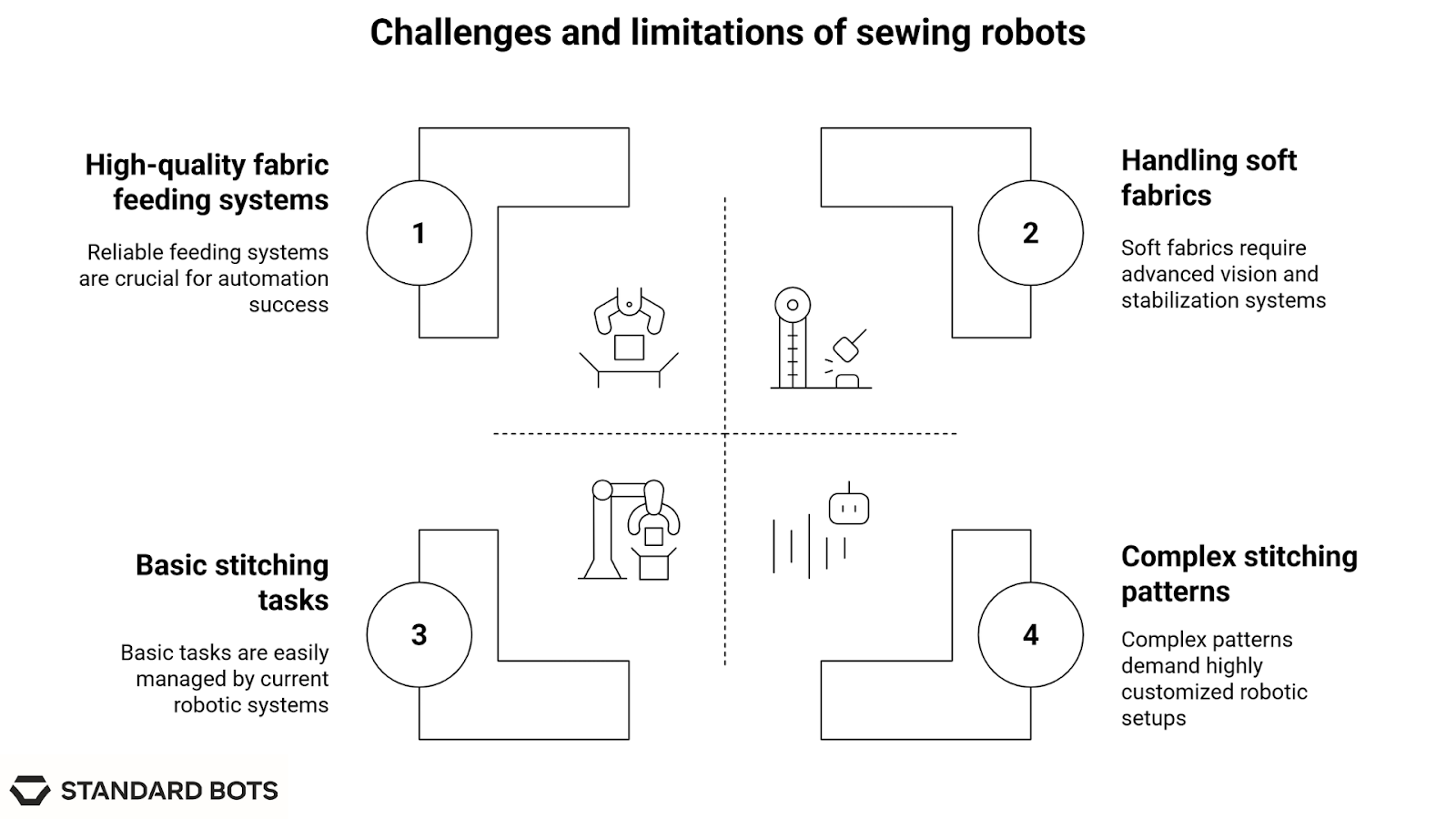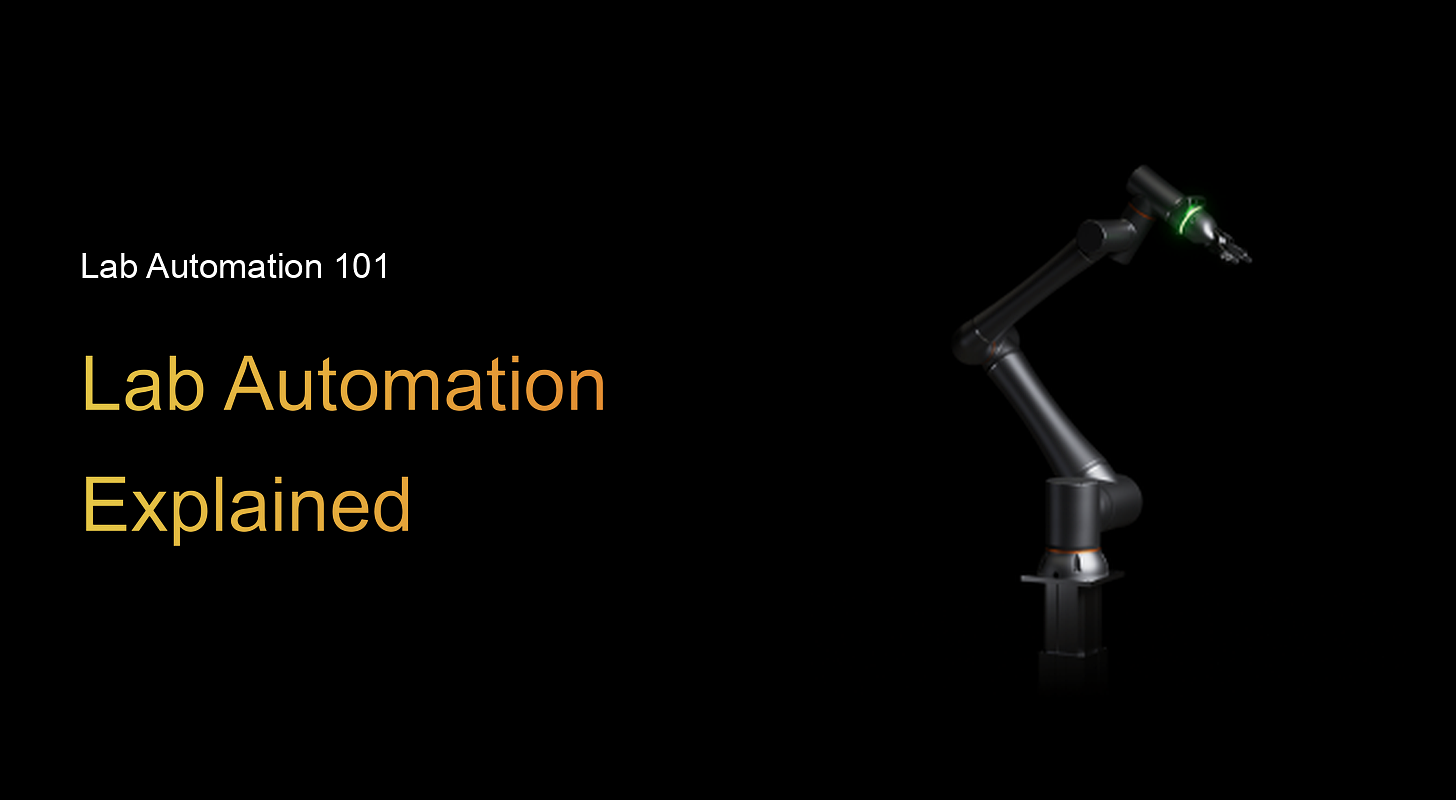Sewing robots can hem a T‑shirt in seconds and stitch the curves of a car seat with precision, all without a human guiding the fabric. These smart machines are taking over some of the most repetitive, time‑consuming jobs in textiles, freeing people to focus on design, quality, and new ideas.
If you're in manufacturing, apparel, or R&D, understanding how a sewing robot works and where it fits in is key to staying ahead in the evolving world of sewing automation.
What is a sewing robot?
A sewing robot is a machine designed to automate fabric stitching with high speed and precision. A sewing robot uses vision systems, robotic arms, and programmed patterns to do the work on its own, unlike a regular sewing machine that needs a human to guide the fabric.
Here’s a quick look at typical 2025 sewing robot prices by type, along with real-world examples:
You’ll often see a few different terms used, but here’s how they differ:
- Robotic tailoring machine: Typically used for made-to-measure or custom-fit garments. It focuses more on fit, shape, and individual adjustments rather than high-volume output.
- Automated sewing machine: Usually refers to a standard sewing machine with digital enhancements like automatic thread trimming or programmable stitches. It doesn’t always involve robotics.
- Sewbot (or sewing robot): A full robotic sewing system that combines robotic arms, sewing heads, and smart software to handle fabric movement and stitching automatically.
Many sewing robots use a mechanical arm as their core component. This is the same type of arm found in many modern industrial robots, providing the precision and movement needed for automated stitching.
Use cases: Where automated sewing fits in
Automated sewing fits in apparel manufacturing, upholstery production, and custom tailoring operations. Here’s how automated sewing is being used in real operations:
1. Apparel and fashion
The fashion industry has been one of the first to adopt robotic sewing machines at scale. Sewing automation is especially effective for high-volume basics where consistency and speed are critical.
- Mass production of T-shirts, jeans, and undergarments: A sewing machine robot can produce thousands of garments per shift. These automated sewing machines help maintain uniform sizing, stitch accuracy, and quality across large batches, reducing the need for manual inspection or rework.
- Seam alignment, hemming, and elastic insertion: These repetitive tasks often slow down human operators or require highly trained labor. Sewing robots now handle them with minimal deviation, helping lines stay efficient while reducing labor fatigue.
2. Upholstery and industrial textiles
In automotive, furniture, and heavy textile applications, robotic stitching machines manage tougher materials and more demanding stitch paths.
- Sewing car seats, cushions, and heavy-duty seams: High-strength stitching is essential for safety and durability. A robot sewing machine consistently applies the necessary tension and precision, even on dense, multi-layered materials. This is especially useful in workflows involving unloading robots, where automation handles finished parts right off the line.
- Handling stretch fabrics and curved seams: Manual sewing of curved or padded components often results in uneven tension or distortion. A fully automated sewing machine equipped with fabric tracking can follow complex curves without slipping or pulling, improving both fit and finish.
3. Custom tailoring and R&D labs
While most automation is aimed at scale, some setups are exploring how robotic systems can support smaller-batch or custom-fit products.
For example:
- Robotic tailoring machines for custom-fit garments: Early versions of robotic tailoring machines are being tested to create garments based on digital measurements with minimal human input. Such precision is powered by systems similar to manipulator robots, which offer articulated control for delicate, multi-axis tasks.
- RO1-style setups combining stitching and machine tending: These hybrid configurations pair a robotic arm with a sewing head to perform both material handling and stitching. It’s a compact approach that enables robot tailors to operate efficiently in small-batch environments. For manufacturers considering similar setups, this guide on machine tending robots offers useful insight.
The rise of automated sewing systems is part of a wider shift toward robotics in production workflows, where consistency and speed matter most.
How robotic sewing machines work
Here's how it works at a functional level:
- Fabric handling: Fabric is tricky; it shifts, stretches, and folds easily. Robotic systems use conveyors, suction devices, or soft grippers to hold the material steady as it moves through the sewing head. This setup ensures that each piece stays flat, aligned, and ready for stitching without manual adjustments.
- Stitching precision: The robot positions the fabric with millimeter accuracy so that each stitch lands exactly where it should. It maintains consistent stitch length and thread tension, even on curves or multiple layers. This eliminates the inconsistencies you get with manual sewing, especially in high-speed production.
- 3D vision alignment: Built-in cameras and sensors scan the material in real time. They track fabric edges, seam guides, and any movement during the process. If the fabric shifts, the system makes instant corrections to stay on track. This is critical when dealing with pre-cut shapes or curved seams.

Control systems and pattern recognition of sewing robots
The control system is the core of any robotic sewing system. It manages every movement of the machine, from fabric handling to stitching paths, based on digital pattern data.
Here's how it works:
AI sewing machine logic: At the core of most robotic sewing setups is a control system that acts like the brain of the operation. These logic systems are what separate basic automation from fully autonomous sewing machines. It handles:
- Motion control for the robot arm and sewing head
- Real-time feedback from sensors and vision systems
- Adjustments to tension, speed, or path if conditions change
- Coordination between fabric feeding and stitch timing
Pattern recognition: Some systems go a step further with visual pattern detection. Using cameras and trained models, the robot can:
- Identify fabric outlines, seam lines, or placement marks
- Match stitching to pre-printed patterns or templates
- Skip manual setup steps like alignment or calibration
Robotic sewing machines rely on the same type of motion control, sensor feedback, and precision used in robot cutting, where machines adapt in real time to the shape and behavior of soft or irregular materials.
Benefits of sewing automation
- Consistency and speed: A robotic sewing machine can repeat the same stitch with the same tension, over and over, without slipping or slowing down. That means fewer defects, less wasted material, and faster turnaround times. Whether you're running a single shift or around the clock, the output stays consistent.
- Lower labor costs and faster changeovers: With fewer operators needed per line, labor costs drop. Changeovers are faster, too. You don’t need to stop the line for manual adjustments, just load a new pattern into the control system and resume. This makes it easier to run short batches or switch between products without losing time.
- Ability to run lights-out shifts: Robotic sewing systems can operate without human supervision once they’re set up, making it possible to run production overnight or during off-hours. This helps increase output without adding extra staff or extending shift hours.
Challenges and limitations of sewing robots
There are still some technical hurdles that manufacturers should be aware of before diving in:

- Handling soft or stretchy fabrics: Lightweight or stretch materials like silk, spandex, or jersey are harder to control. They shift under pressure, stretch unevenly, and can slip out of alignment mid-stitch. Some systems can handle them, but performance varies and usually depends on the quality of the vision system and how well the fabric is stabilized.
- Complex stitching patterns and tension control: Decorative stitches, multi-layer seams, and variable tension patterns still challenge robotic systems.
Robotic systems can manage basic and mid-level stitching tasks well, but once you get into intricate patterns or irregular shapes, reliability tends to drop without highly customized setups.
- Need for high-quality fabric feeding systems: Feeding fabric smoothly and consistently is critical. If the fabric bunches, stretches, or misfeeds, the entire process breaks down.
Many failed attempts at sewing automation come down to poor material handling, not bad stitching. Investing in reliable feeders, tensioners, and holding tools is just as important as the robot itself.
If you’re considering automation, it helps to understand how robots perform in real production settings. Seeing where they deliver consistent results and where human expertise still plays a vital role can make it easier to decide how and where to integrate them into your workflow.
How to integrate a sewing robot into your shop
Adding a sewing robot to your operation doesn’t have to be disruptive. With the right setup, most teams can get up and running quickly without rewriting their entire process.
- Staff training and no-code options: Many modern sewing robots are built with no-code or low-code interfaces, making them accessible even to teams without a robotics background.
Operators can be trained in just a few days to run, monitor, and adjust workflows. For shops already using programmable equipment, the learning curve is minimal. Some systems even include visual programming or drag-and-drop interfaces that remove the need for custom coding.
- Retrofit vs greenfield: Retrofit setups let you integrate a sewing robot into existing stations by pairing it with your current equipment. This is a cost-effective option for manufacturers that want to automate a single task or add capacity without major downtime.
Greenfield setups are better suited for new facilities or major upgrades. Starting from a clean slate allows you to fully optimize layout, material flow, and robot placement around automation from day one.
- Connect it to upstream and downstream tasks: A sewing robot works best when it’s part of a connected workflow. Pairing it with other automation tools, like machine loading robots, can eliminate manual fabric handling. This not only frees up staff but also keeps material flow consistent between stations.
Is automated sewing the future of textiles?
In 2025, sewing robots range from compact retrofit units for niche tasks to fully automated systems capable of running lights-out shifts. They excel in high-volume apparel, heavy-duty upholstery, and precision custom tailoring by delivering consistent stitches, faster cycle times, and reduced labor costs.
Challenges remain with delicate or stretchy fabrics, complex patterns, and material handling, but advances in vision systems and no-code controls are closing the gap. Whether you’re scaling production or exploring small-batch automation, sewing robots are now practical, accessible, and adaptable to a wide range of textile operations.
Next steps with Standard Bots
Looking to upgrade your sewing automation? Standard Bots’ RO1 is the perfect six-axis cobot addition to any textile production line, delivering unbeatable precision and flexibility.
- Affordable and adaptable: RO1 costs $37K (list). Get high-precision automation at half the cost of traditional robots.
- Precision and power: With a repeatability of ±0.025 mm and an 18 kg payload, RO1 handles even the most demanding CNC jobs.
- AI-driven simplicity: Equipped with AI capabilities on par with GPT-4, RO1 integrates seamlessly with CNC systems for advanced automation.
- Safety-first design: Machine vision and collision detection mean RO1 works safely alongside human operators.
Schedule your on-site demo with our engineers today and see how RO1 can bring AI-powered greatness to your sewing work.
FAQs
1. Can a sewing robot handle stretchy or delicate fabrics like silk?
Yes. A sewing robot can handle stretchy and delicate fabrics like silk, but it requires specialized technology and careful setup. Advanced systems use precision tension control, fabric stabilization tools, and high-resolution vision sensors to prevent distortion or slippage during stitching.
2. How do you train existing staff to program and maintain an automated sewing system?
Training existing staff to program and maintain an automated sewing system requires a multi-faceted approach. This includes skill assessment, focused training, hands-on practice, and ongoing support to ensure operators can run and maintain the system confidently and efficiently.
3. What ongoing maintenance does a robotic sewing machine require?
Ongoing maintenance for a robotic sewing machine includes regular cleaning, lubrication, needle and thread replacement, and software updates. It also requires preventive inspections of electronic components and calibration checks to ensure optimal performance and avoid downtime.
4. Are leasing or subscription options available for sewing robots?
Yes. Leasing or subscription options, such as Robots as a Service (RaaS), are available for sewing robots. These programs let businesses access the technology without large upfront costs while offering flexibility and scalability. Packages often include the robot, software updates, maintenance, and support.
brighter future
Join thousands of creators
receiving our weekly articles.







.png)


